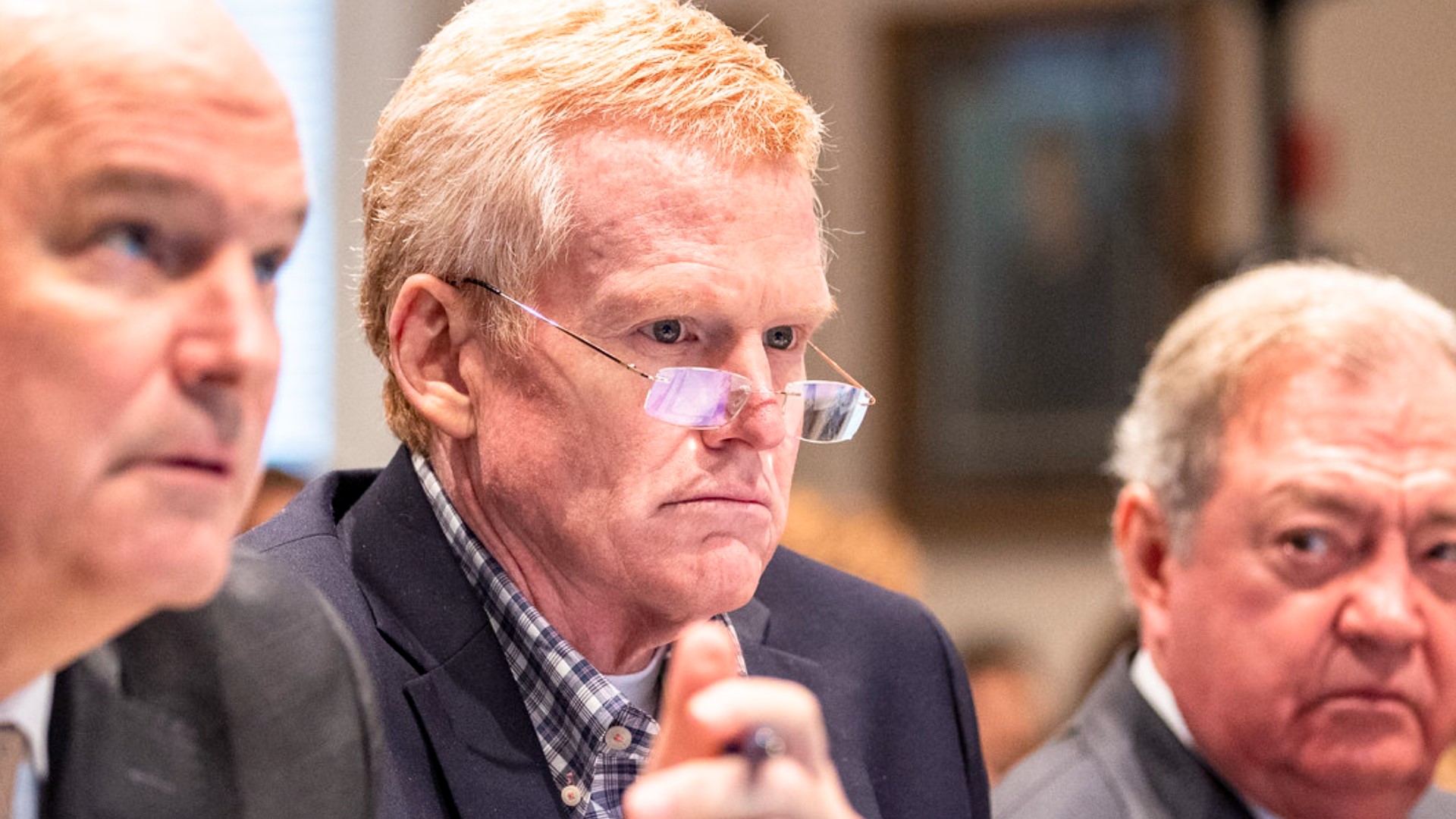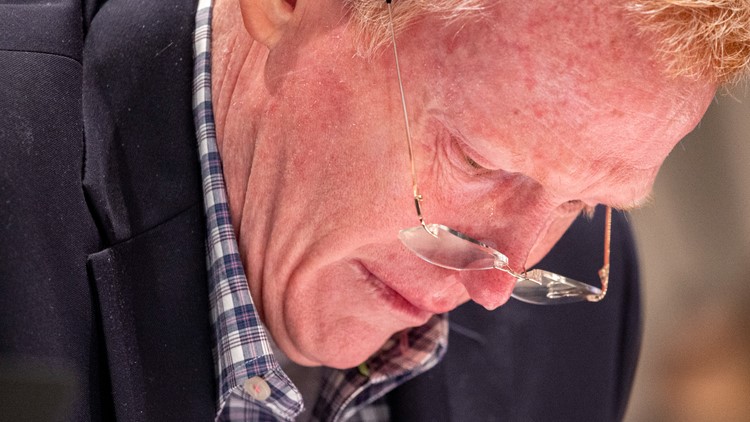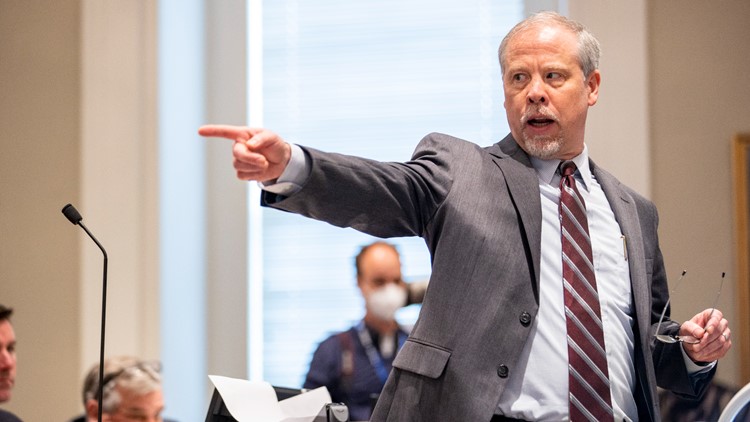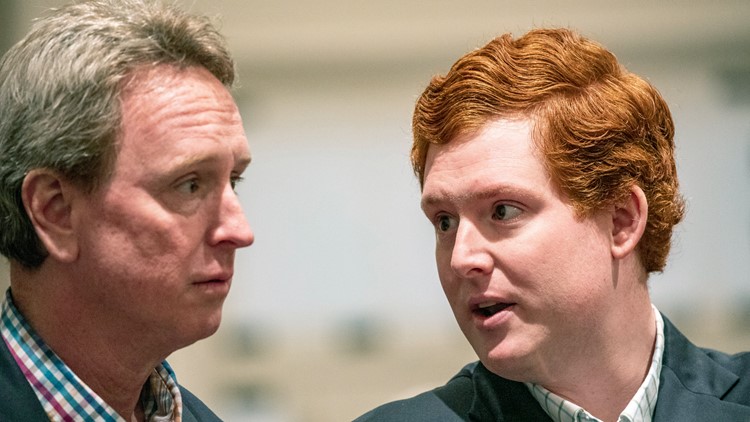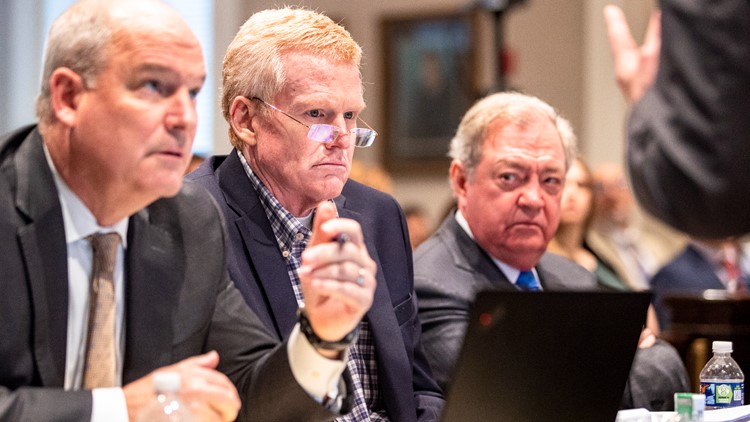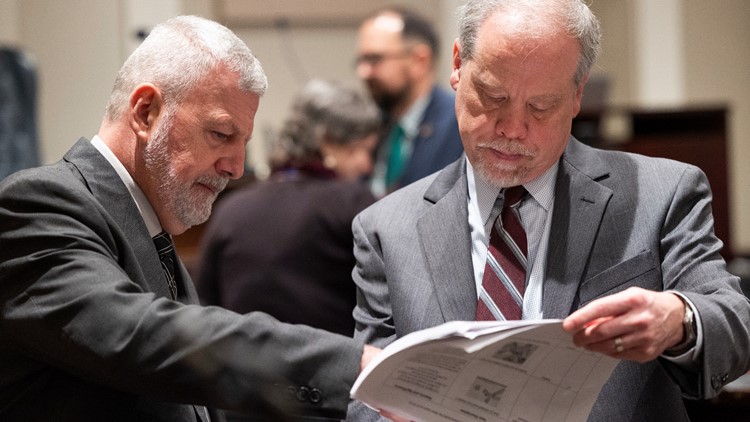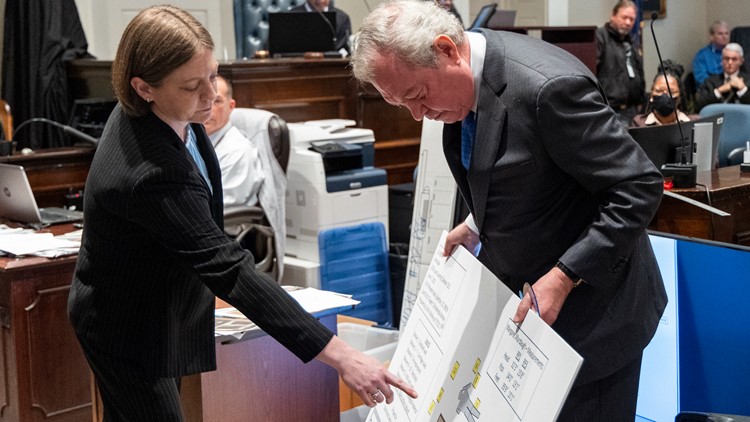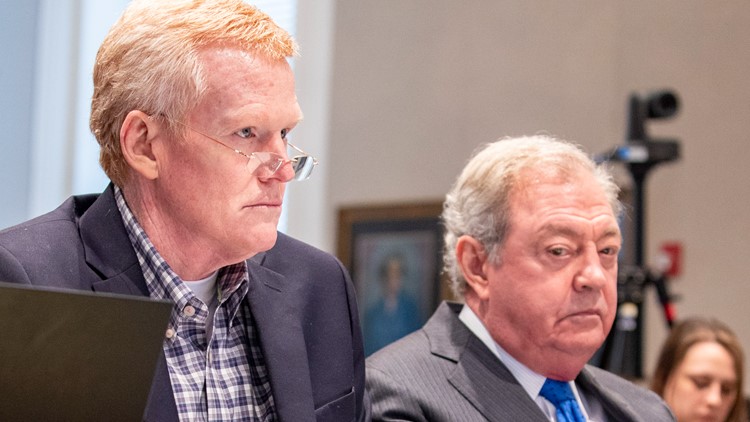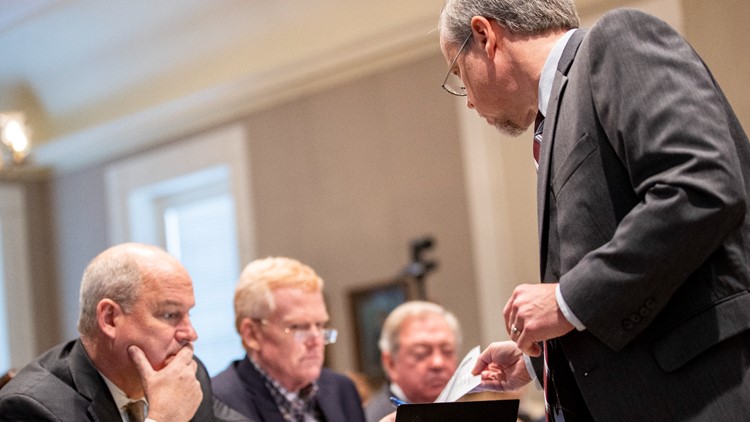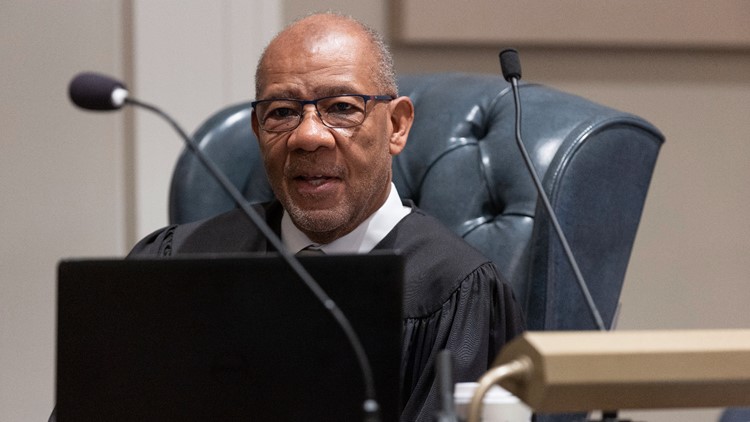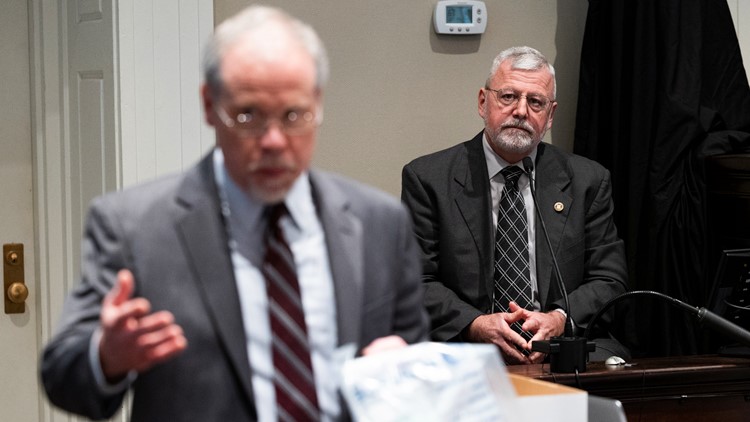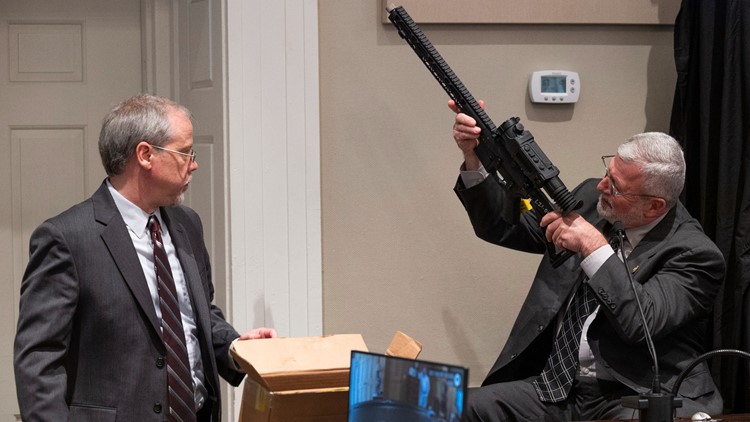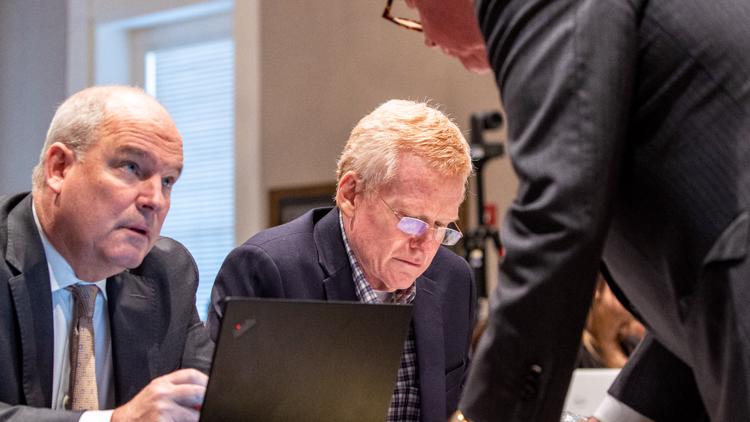WALTERBORO, S.C. — The double murder trial of Alex Murdaugh continues Monday with a continued focus by the prosecution on evidence collection on the night of the killing.
Murdaugh is accused of killing his wife, Maggie, and adult son, Paul, at the family's Colleton County estate in South Carolina in June of 2021. Murdaugh's attorneys maintain their clients innocence and say investigators rushed to judgment.
Defense attorney Dick Harpootilian’s cross examination of SLED Agent Melinda Worley begins the Monday, Jan. 30, session.
On Friday, Worley took the stand Friday afternoon to answer questions about SLED’s methodology of collecting evidence at the Moselle crime scene on June 7, 2021. Worley also was called on to assist the prosecution entering hundreds of pieces of evidence into court.
Earlier on Friday, Collecton County Sheriff’s Office detective Laura Rutland was on the stand. She testified she was the one to obtain the search warrant for the Murdaughs’ Moselle property and was named the liaison to South Carolina Law Enforcement Division’s lead investigator David Owen when it was determined SLED would be in charge of the murder case rather than CCSO. Rutland was present when Owen conducted his first official interview with Alex Murdaugh the night of the murders of Paul and Maggie Murdaugh. It was her testimony that Alex Murdaugh appeared clean and unbloody even after he allegedly touched both the bodies of his wife and son, and she noted certain aspects of his interview that seemed odd to her.
Murdaugh is charged with the June 2021 killings of his wife, Maggie Murdaugh, and his adult son, Paul Murdaugh, at their Moselle property at the Hampton and Colleton County line. Prosecutors and law enforcement say Paul was killed by two shotgun blasts, Maggie was shot five times with a 300 Blackout rifle. The defense maintains their client is innocent and say law enforcement rushed to judgment in pointing the finger at Alex Murdaugh.
After three days, the jury was finally seated in the case Wednesday, Jan. 25. The 12 member panel consists of eight women and four men, with six alternates as standbys. Both sides presented openings statements before the end of Wednesday, so prosecution witness testimony took up much of Thursday.
You can find updates throughout the day on this article. Live streaming coverage can be found here as well, on the WLTX+ streaming app on Amazon Fire and Roku TV, and on the News19 WLTX YouTube page.
Key Things to Know in the Alex Murdaugh trial
- Murdaugh was a prominent attorney whose family has a long history in the legal community
- He’s also facing other charges that he embezzled millions from his law firm and stole money from clients
- Investigation into this crime led to other probes into mysterious deaths associated with Murdaugh family
- Trial is expected to last around three weeks
Monday morning session, Harpootlian cross-examination
SLED Agent Melinda Worley
Defense attorney Dick Harpootilian began his cross examination of SLED Agent Melinda Worley. She is currently a senior criminalist, spending most of her time in the labs. At the time of the murder, she was a special agent that responded to crime scenes.
Worley testified she got the call to report to the scene at 1030 p.m. June 7 in Columbia and arrived at Moselle 12:07 a.m. June 8.
Worley says the Colleton County Sheriff’s Office (CCSO) was to secure the scene, not collect evidence, and that CCSO did mark evidence that was found at the scene.
PHOTOS: Alex Murdaugh murder trial - Day 6
Harpootlian brings up a bloody footprint that was not Paul’s or Alex’s and questioned whether law enforcement may have contaminated the crime scene. He asked if by walking around in the dark, CCSO officers may have disturbed evidence such as location of spent ammunition. Worley says CCSO was probably trying to preserve evidence by marking what they saw and could not determine with certainty where the footprint came from.
He asks Worley to identify her final crime scene diagram she created.
Worley had done a crude mark up of location of buildings, bodies, spent shells, and other evidence, after she walked the crime scene, but that initial diagram was not to scale. She took measurements of the location of each piece of evidence to make a more defined and to-scale diagram later. She testified she used a corner of the feed building as a reference point for all measurements.
Harpootlian asks if Worley measured the dog kennel in relation to a certain reference point. Worley says she doesn’t believe so.
Harpootlian shows Worley a photo of the crime scene showing the dog kennel (small animal cages, doghouse and door to the feed room) and asks if she did measurements from the animal cages to the feed room. She says not directly from the cage to the door. She says her measurements were taken initially the night of the murder and additional measurements were taken on June 16.
To her knowledge, no other measurements were taken from the cages to the door of the kennel.
Harpootlian asks Worley if FARO, a scanning device that recreates a 3-D image of the crime scene, was used on June 16 when SLED returned to the crime scene. He said the State had not entered this evidence.
Harpootlian says FARO created a drone-like video of the scene and presents the video as evidence. This portion of the FARO video shown to the court is of the doghouse and the inside of the workshop.
Harpootlian stops the video at several points during the presentation to show: where the bullet that went through the quail cage and continued through the wall and into some dog bedding; where the bullet comes into the kennel and enters the dog bed; the location of the dog beds inside the kennel; a chicken coop outside the kennel; and a structure about 100-150 feet away from the kennel that houses farm equipment.
He asks if Worley knows how FARO compiles the image. Worley says investigators take physical measurements, and use a 360-degree camera and lasers to produce video images for documentation. She did not render the final FARO video.
Harpootlian is questioning the chain of evidence the video has gone through. Worley does know recall who ordered the FARO, she testifies she was told to gather the measurements.
Harpootlian says the video only came into SLED’s custody about three months ago.
He asks Worley to identify more photos.
She says they are photos taken of the doghouse on June 16. Some of the photos were taken to determine the angle of the bullet entering the doghouse.
Again, Harpootlian asks Worley if she took measurements of the quail cages. He refers to a photo of one of the diagrams she created of the quail cage. Defects are noted sides of cage. Worley said a flight path rod was placed in the cage from the entrance to the exit to determine the path of the bullet that caused the defects.
He asks how the flight path was determined as to the exterior wall.
Worley said the angle of the shot was 41 degrees from the flat surface of the wall. Worley said a protractor was used to determine the angle in the small cage area, and the same process was used in the doghouse. The angle there, Worley says, was approximately 84 degrees.
Harpootlian asks if Worley can show the jury the angles of the bullets on her sketch, using a protractor. She uses an enlarged diagram presented by Harpootlian to draw out the angles of the bullets.
Harpootlian asks Worley, if you look at the photographs and the diagram and the location of the feed door, the trajectory of both shots would have come from away from the buildings?
He says one of the shots from the AR-Blackout would have come from away from the feed door. The trajectory of the AR shows the shots from that gun were further away. Does this lead her to believe there were two shooters? Was there a possibility of two shooters based on the measurements she took?
One explaination, Worley says, is the movement of one shooter.
Harpootlian says a reasonable explanation would be there are two shooters, using two guns, and the AR is being fired from a second position.
Worley says the AR could have been shot from any point along the trajectory.
Harpootlian asks again about the angle of the trajectory in the doghouse. She says 84 degrees. Harpootlian asks, not 90?
He presents her early diagrams of the scene and points out a notation. Worley reads off “80-something degrees.”
He asks what does the notation “96 degrees” mean? Worley says her notes say 84.
Harpootlian asks if the shots came to the right of the feed room? Worley says yes.
He turns to the footprints in and around the feed room. Worley said she was able to attribute them to Paul’s shoes.
She explains an L-scale is placed near the shoe, the camera setting is set to “raw” to digitally document the shoe (or other evidence).
Harpootlian says there should have been good lighting, a scale placed next to the shoe and photos taken straight on and above. He asks her if that had been done the first night. She says there was no indication of foot prints in the room at the time.
He asks about a possible footprint impression on the back of Maggie’s calf.
He suggests the process used that night was not proper and there may have been evidence excluded from the scene.
He asks if Worley about another one of the crime scene photos.
In the photo, Paul is facing backwards away from where he was shot.
Worley said Paul was stepping back after he was initially shot, leaving footprints in the building.
Harpootlian said the shotgun blast to the chest didn’t kill him but the second shot to the head splattered his brains across the ceiling and door and part of the brain was at his foot.
Worley testifies SLED did not ask her how Paul was turned around the way he was. He was near the door when shot the second time.
A second footprint was eventually determined to be from a law enforcement officer, Harpootlian said. Is that standard procedure, he asks Worley, and does she know of any more evidence that may have been destroyed by law enforcement? She answers she does not know. Harpootlian responds, you’re right, we don’t know.
Worley says she accounted for the footprints found in the feed room.
Another photo is presented showing Maggie’s body.
Harpootlian asks to zoom in on the back of her leg where some sort of pattern is present. He asks if Worley had seen this photo. She testifies this is not the photo she used in her footwear identification. Harpootlian asks Worley to point out the pattern on Maggie’s leg. She says there is a distinct pattern in the print on the leg.
Harpootlian says there is no scale on the photo to show approximate size of the print and asks if this went against standard procedure. By calling into question SLED’s evidence gathering that night, Harpootlian said no one treated the impression as one being made by footwear, so no standard procedure was used to document the possible footprints at the scene of the murder.
Harpootlian turns to collection and tests of Alex Murdaugh’s clothing. Worley testifies she saw the clothing was taken, laid out flat and photographed on a diagram to show scale before the chemical test was applied, and the clothing photographed again after the chemical test took effect. The clothing shows "creasing here and there," says Harpootlian, and is not completely clean.
Worley said after spraying the shirt, the clothing was placed on a grid to show the location of any stains found on the clothing. The chemical would have shown locations of presumptive blood or bleach or rust on clothing.
The tests, Harpootlian said, showed presumptive evidence of blood and then further testing showed the stains were not human blood. Worley said she was unaware of further testing done on Alex Murdaugh’s clothing and did not see the test results.
Harpootlian says he needs to check Worley on something, because her initial measurements say one thing and her official notes say another.
ON REDIRECT
Prosecutor Savanna Goude asks why did Worley prepare the diagrams? Worley said they were done for reconstructive purposes.
Her diagrams were not to scale, but were an approximation as to where things were in relation to one another.
Goude asks if there was stippling present on Maggie's body, and what it meant. Worley said there was, meaning she was shot at close range.
Goude asks if a person shooting could move around and if a single shooter could have used two guns. Worley says it is possible.
Goude asks if there were a lot of bloody footprints in the feed room. Worley says yes.
Goude asks if the bloody footprints were Paul’s and Worley says yes. Closer to the physical door was a partial print consistent with Paul’s shoes. Goude asks if any other prints found there could have been after SLED moved Paul’s body and the crime scene was documented? Worley said yes.
Goude asks about the mud on the back of Maggie’s leg and if it was a footprint? Worley said she did not see the photo.
Goude asks where was Maggie’s body in relation to the ATV on the night of the murder? Worley said her body was toward the right of the ATV near the kennels
Worley said she saw biologic matter on the ATV and the ATV’s tire the night of the murder.
RE CROSS
Harpootlian asks if the biologic matter was collected for testing for blood. Worley says no samples were taken from the ATV
Harpootlian asks if samples of the water surrounding Paul’s body. Worley said no
Harpootlian asks if the photos of the footwear were adequate to determine who made footprints at the scene? Worley said she could approximate the tread identification through the size of the nearby spent ammunition.
Worley says she processes but does not do crime scene reconstruction. She testifies she was never approached about a crime scene reconstruction at SLED or the State Attorney General’s Office.
SLED Senior Special Agent Jeff Croft.
The State then calls SLED Senior Special Agent Jeff Croft. Prosecutor John Meadors is handling this witness’ testimony.
Croft testifies he joined SLED in investigative services in 2012, working financial cases and violent crime in the Lowcountry Region. He was called to the scene the morning of June 8 and rerouted to the field office in Walterboro for instructions.
Croft testifies his first interview was with Rogan Gibson, a friend of the Murdaugh family, on whether he had phone communication with Paul, Alex, and Maggie on June 7, the night of the murders. Croft said Gibson told him he had communicated with the Murdaughs that night and voluntarily handed over his cell phone for evidence.
Croft testifies he took screen shots from Gibson’s phone, showing incoming an call from Paul at 8:40 p.m. June 7, 2021, approximately 4 minutes in length. Another screen shot shows an incoming call from Paul at 8:44 p.m. to Rogan Gibson. A third screen shot shows a text between Gibson and Paul, reflecting a text from Gibson at 8:49 p.m., asking about a dog. A fourth screen shot from Gibson to Paul at 9:58 p.m. saying, “yo.”
Croft testifies a log of outgoing calls from Rogan Gibson to Paul 9:10 pm, 9:29 p.m., 9:42 p.m. and 9:57 p.m. and at 10:08 p.m. that went unanswered.
Rogan Gibson texted Maggie at 9:34 p.m. asking her to get Paul to call him.
A series of missed calls from Rogan Gibson to Alex Murdaugh are recorded at 10:21 p.m. and 10:24p.m. and 10:25 and 10:30 p.m.
Croft testifies swabs were taken from Gibson to get a DNA baseline for comparison to any evidence at the scene, and a chain of custody of Rogan Gibson's DNA sample was entered into custody.
After the interview with Gibson, Croft testifies he updated senior SLED investigator David Owen at the scene and began collecting firearms from the residential house at Moselle.
Croft said he knew firearms and his role was to collect and possibly test firearms that might have been used in the murders of Paul and Maggie, and to identify any firearm capable of using ammunition consistent with 300 Blackout.
Croft identifies two recordings of his body cam footage showing his entry to the Moselle residence. He testifies in one of the recordings, he noticed 300 Blackout shell casings outside the door to the gun room and in flowerbeds outside the room that needed to be marked and collected for evidence.
The footage is played for the court with the audio off (due to future witnesses being present in the courtroom) and Croft supplies a “play-by-play” of footage from Moselle.
Croft testifies 300 Blackout casings were found outside the residence. He describes the footage of him being introduced and shaking hands with three of Alex Murdaugh’s former law partners who are present at the scene. Croft is then shown standing in front of the gun cabinet as SLED special agent Katie McCallister explains what they are looking for and why they are there.
Consent to search the property had been granted.
Mark Ball and a SLED agent point to a 300 Blackout rifle in the cabinet. Croft walks to the gun cabinet to get a better picture of the firearm. Croft looks at the magazine on the firearm and it marked 223, capable of handling 300 Blackout ammunition. Croft explains the 300 Blackout ammunition is bigger and has more kinetic energy than 223 ammunition. The 223 does not have the "stopping power" of the 300 -- the 300 ammunition has more impact than the 223.
Croft is looking for firearms capable of shooting 300 Blackouts and shooting 12-gauge shotgun shells. Croft found only one 300 Blackout rifle in the gun room.
The video continues and stopped at an image of a box of ammunition that Croft identifies -- noting the weight of the ammunition inside as 147-grains (indicating the weight of the projectile, ammunition of the same caliber can have different weights) and S&B, 300 AAC Blackout.
Croft was to also collect 12-gauge shotguns found at the scene.
The video is fast forwarded again to a point showing John Marvin Murdaugh, Alex’s brother, in the gun room along with three attorneys who were part of Murdaugh’s firm, and Chris Wilson, another attorney who steps in for a moment.
Croft can be seen putting on latex gloves to secure the firearms in the gun room. He picks up an AR-15 chambered for 300 Blackout ammunition. Then he picks up the magazine he has taken from the gun containing 300 Blackout.
From the witness stand, Croft shows the court the 300 Blackout rifle secured at the scene and magazine and ammunition Croft removed from the gun. The headstamps on the ammunition in the gun room are the same as the headstamps on the ammunition used to kill Maggie Murdaugh. There is also a thermal scope on the gun that can be used to fire in the dark. The rifle is a semi-automatic, meaning each pull of the trigger shoots a bullet and ejects its casing from the gun upon firing.
Croft then identifies he is holding a 12-gauge Browning rifle on the video. The Browning was also collected for evidence.
Again, from the witness stand, Croft shows the court the 12-gauge Browning taken from the Moselle gun room.
Defense attorney Jim Griffin objects to entering the guns into evidence and is overruled by Judge Newman.
Croft testifies he is selecting shotguns on the basis of if the gun was chambered and if it is a 12-gauge. Croft says the 12-gauge shotgun he is holding in the video is a pump action, the breach is open and in the breach, a shotgun shell is ready to be chambered and ready to be fired.
Other 12-gauge shotguns are entered into evidence: a second 12-gauge pump-action with an unchambered open breach with turkey load shot; and a Benelli and its two 12-gauge shells that were in the gun when it was secured – one Winchester 12-gauge longbeard 3-inch #4, and a Federal 12-gauge 7-2 ½ ounce shell. Croft testifies he did not see any other 12-gauge shotguns in the rack at the time.
Croft says the other man in the video is attorney Mark Ball who is seen on the video pointing to a box on a shelf in the cabinet.
Croft testifies the remaining video shows Croft and other agents collecting spent and unfired ammunition from the scene.
Meadors asks Croft about a portion of the video that shows what might be a juice box container and the further collection of firearms and ammunition. At one point, attorney Chris Wilson is seen sitting on a couch in the residence.
Meadors fast forwards the video to Croft exits the building to talk to his supervisor Capt. Ryan Neal. After talking to Neal, Croft asks another SLED agent to assist in securing spent and weathered 300 Blackout ammunition from around the stoop of the gun room. The spent shell casings collected outside the gun room appeared to have been sitting in the weather for a while. Croft said they were tarnished, not shiny like the others taken from the scene. Inside the casings, there was dirt and grass.
From the video, Croft points out the collection of S&B 300 Blackout shell casings from the left side of the door leading outside from the gun room.
Croft is asked if he searched the shed or other area of the property. Croft said he returned later to search the trash near the shed. Another video of Croft’s body cam footage shows Croft near the shed, to the right are the dog kennels and a chicken coop. Under the shed is the ATV near to which Maggie's body was found.
From the video, Croft identifies empty boxes of 12-gauge turkey load, 12-gaurge longbeard, and 12-gauge Browning ammunition; and a credit card statement from Gucci, with an item circled on it for $1,021.10. He notes there was nothing else of note found in that trash.
Meadors asks Croft if he recognizes a piece of evidence in the courtroom. He identifies the shell boxes and the credit card receipt he just described in the video that were collected from Moselle.
Croft testifies he and other agents did return to the property on June 13 to search for more firearms and ammunition to be tested for potential weapons used in the murders. They collected more 300 Blackout ammunition and a magazine.
At this time, Judge Newman breaks the court for lunch at 1:15 p.m. and Croft’s testimony will continue after the break.
The State continued testimony with SLED Senior Special Agent Jeff Croft after the lunch break.
Assistant prosecutor John Meadors asks for clarification of earlier testimony as a point of “housekeeping” before continuing. He asks Croft about a set of photographs previously entered into evidence. Croft identifies them as still images taken from his body cam video.
One image is of the pool table in the gun room with the AR-15 Blackout rifle on the table; second image is of the AR-15 in the gun rack before being removed; a photo of gun casings on the stoop outside the side door to the gun room; the brick landing at the bottom of the stoop with a spent 300 Blackout casing; Croft’s hand picking up a spent 300 Blackout casing; the five casings collected from the stoop; casings in the flowerbed next to the stoop; and photos of more casings found outside the Moselle residence.
Croft testifies some of the ammo in the photo was collected from the shelf in the gun room. The 223-magazine, “nearly full” with S&B 300 Blackout ammunition, was collected from a black truck on the property. And two other magazines that fit the AR rifle contain 300 Blackout ammunition.
Meadors asks about June 8, 2021. He asks Croft if he was present when collecting Maggie’s cell phone. Croft says he was present. The phone was a short distance from the crime scene, about a quarter/half-mile from Moselle in the grass on the side of the road. Croft was given the passcode to verify it would unlock and then the phone was shut down and passcode recorded, the phone secured and handed over to be booked in evidence. Croft identifies the phone presented to him in the courtroom as Maggie’s cell phone that was recovered by the side of the road.
Meadors asks if Croft knows a man named John Bedingfield. Croft said he and Bedingfield grew up together in Barnwell and Bedingfield is a South Carolina Department of Natural Resources (SCDNR) officer with a side job working on and assembling firearms. Croft had talked to Bedingfield about assembling guns for Alex Murdaugh -- specifically guns built and chambered for 300s. Knowing that, Croft contacted Bedingfield and asked him to supply him with paperwork of the guns he had assembled for Alex Murdaugh. Croft also talked to Bedingfield about an additional 300 Blackout purchased by Maggie, and if third 300 Blackout was a replacement for the gun Paul had misplaced or got stolen. Bedingfield supplied Owen with the paperwork, including cancelled checks and the bill of sale.
Croft identifies another body cam video form June 16, 2021, from a subsequent search of Moselle.
Meadors asks Croft to talk about the June 16 search.
Croft said information came to SLED about a shooting range on the Moselle property and a nearby pond that might be needed to be searched.
Croft testifies he was sent out to the property to search the shoot house and the area next to the waterway on the property. Croft’s body cam recorded the event.
There are images from the body cam video of the search of the inside and outside of the shoot house. The shoot house has spent brass on the floor and there are spent 12-gauge shots along the waterway.
Croft is asked to narrate what’s going on in the video.
The agent says the shooting house is as he found it, shells on the floor and a rest on the counter used to hold a rifle still in position so as to sight on a target downrange. “To shoot where you’re aiming,” Meadors asks. “Yes sir,” Croft responds.
At 11 minutes and 3 seconds into the video, Croft is reading off the identifiers on the shell casings being collected at the shooting house -- S&B 300 AACBLK can be heard over and over again. Croft and another agent continue for about another 15-20 minutes collecting 300 Blackout shells. Croft testifies the team runs out of evidence envelopes and have to get more envelopes before continuing to collect more shells. Croft says spent and unspent 300 Blackout shells were collected from various places throughout the Moselle property.
In an area between the shoot house and the waterway, Croft testifies he and his team locate spent and unspent 12-gauge shotgun shells.
Croft, in addition to collecting evidence, also participated in interviews of Rogan Gibson, John Bedingfield – and Alex Murdaugh (on June 10, 2021).
The second Alex Murdaugh interview with law enforcement
Croft testifies he and senior agent David Owen interviewed Alex Murdaugh at his brother John Marvin’s hunting lodge on June 10. The interview is recorded. The following passage is from Alex’s interview with Owen and Croft:
Alex Murdaugh gives consent to download his phone's data and his smartphone is then handed to attorney Dylan Hightower, with the 14th Circuit Solicitor’s Office.
Murdaugh tries to make small talk with the officers while his phone data is being dumped to law enforcement, asking where they’re from and who they might be related to. Murdaugh says “Big John” Bedingfield -- the gunmaker -- is his cousin.
Murdaugh tells Owen and Croft what he was doing on the day of the murders – he was at his office working on motions in a Dominion Energy case and on the boat case. He doesn’t remember who was there at the Moselle house when he left for work. Maggie may have been there, but Blanca the housekeeper would remember. Murdaugh says he left the office earlier than normal because Paul was coming home and the two of them were going to plant sunflowers on the property the next day. Alex said he and Paul went riding around the Moselle property, looking for hogs, checking fields, “other bullsh*t,” he says. Paul was working for his brother John Marvin and coming to Moselle after work.
Alex says he and Paul had rode around comparing corn fields the two had planted. Alex says in the interview that Maggie wasn’t home yet. Alex said he and Paul used a 22 Magnum to shoot at a bottle (a small round compared to the 300 Blackout ammunition) while out riding.
At some point, Alex says on the recording, he and Paul and Maggie were all at the house together, they usually eat supper together. Alex said Paul was having high blood pressure issues and Maggie was concerned.
Alex says they hung around the house after supper -- Maggie went to the kennels (Alex says normally she would drive an ATV or walk), Paul left the house, and Alex assumes he went to the kennels.
Alex said he stayed in the house after Maggie and Paul left the house and watched TV and fell asleep on the couch. He doesn’t remember when he woke up but says the first thing he did was call Maggie, she didn’t answer the call so he sent her a text before he went to his mother’s house.
Alex says he was certain he heard them pull up before he left, but they didn’t. He says he had the impression it was a car that pulled up. When he went outside, he said, and there was a wildcat that lived around the house and Alex said he was under the impression it was the wildcat, not a person running away from his vehicle. He left Moselle, went to his mom in Almeda and talked to her caregiver for a few minutes. Alex says on the video he called his brother John, a friend Chris Wilson, his son Buster (in Rock Hill), and some other people while driving home from his mom's.
Alex then said he got back to the Moselle house and no one was there. He said he went to the kennels and saw Maggie and Paul and no one else. He said he “knew it was bad” and called 911.
He says drove back to the house to get a gun because he “was freaked out.”
When Owen asks him who stands out in his mind, who would come after Paul or Maggie, Alex says he can’t think of anybody. Paul had some threats, Alex says, but he has no idea who would do this.
Owen asks about the threats and Alex says they were in-person threats, where people would come up to his son in public and threaten him. Paul spent the night on Wills Chapman’s couch in Charleston two nights before he was murdered.
Riding around with Paul that day, Alex says he was acting normal, he was a great kid.
When asked, Alex said his biggest problem he had with Paul is his ADHD, he couldn’t focus. He had “clothes and guns strung out across the state. He would go off for the weekend and not pack clothes because they were strung out in people’s homes,” Alex said.
Alex is asked about Maggie’s doctor’s appointment in Charleston. He can’t recall exactly the doctor’s name. Alex says he and Maggie and Paul were at University of South Carolina’s regional baseball games the weekend before.
He says the night of the murders, Maggie got home sometime after Alex and Paul went riding on the property. She was home when Alex and Paul got back from their ride.
Alex said his relationship with Maggie was "as good as it possibly could be." Their biggest arguments were about her wanting to go or stay with her parents longer than Alex and the boys wanted to stay, according to Alex. “We didn’t have too much to argue about,” Alex said on the interview.
Alex can be heard breaking down in tears at this point in the interview.
He recovers about a minute later and Owen asks Alex about his ride with Paul. Did they go near the kennels? Alex says they were in two trucks, the black one and (Paul’s) white F-250.
Alex is asked about the firearms he owns. “Paul had guns scattered all over the place,” he says. “Whatever was in the house on Monday is exactly what he (Alex) owned, with the exception of the 12-gauge” shotgun collected by SLED on the night of the shooting. Alex says, “Paul had a 300 Blackout he says got stolen. It’s been gone for a long time.”
Meador asks Croft what did Murdaugh tell you about Paul and hogs during the interview? Croft says Alex said Paul would shoot at wild hogs using his brother’s 300 Blackout.
Back on the interview tape, Alex asks if he should run down a list of guns he has, he moved some guns around from one room to another.
Meador asks Croft about his body cam footage and if another set of agents were sent out to collect guns that might match the guns used in the shooting. Croft said yes, but only the guns collected were the ones he took from the gun room.
Back on the interview tape, Alex said “Paul left guns everywhere.”
Alex wasn’t convinced Paul’s gun was stolen rather than lost, and didn’t do an official report about the missing 300 Blackout.
Alex had bought guns for Paul and Buster and Alex was certain Paul got a 300 Blackout replaced. It is his memory, Alex says, that the third 300 Blackout “had been gone for a substantial amount of time.”
Alex tells the investigators that Buster’s 300 Blackout was black, Paul’s was black and tan, and Alex is sure Paul’s 300 was replaced at some point.
Owen asks Alex about Claude “CB” Rowe, the caretaker, and the story Alex relayed about him in his first interview. (According to Alex, Rowe told Paul a story about getting into a fight with a Black man and an undercover FBI agent saw it and recruited Rowe to be part of a team with ex-Navy SEALS whose mission was to assassinate radical Black activists.) Rather than talking about the story again, Alex asks Owen if he feels if the murder wasn’t random and if Owen has formed an opinion. Owen tells Murdaugh doesn’t know what to think. The autopsy and evidence collected will tell the story.
Owen tells Alex Murdaugh he will need to take a DNA swab from him to possibly eliminate him as a suspect in the case.
After a pause, Alex says Paul was an intuitive dude. And Alex says he could point Owen to a few people, but “Paul was super, super secret about his phone. It would surprise me greatly if someone knows (the phone’s passcode).”
Owen tells Alex they want Paul’s passcode to see who he talked to and maybe get an idea as to a suspect in the case.
During the interview, Croft goes over the timeline again for the night of the murder. This time, Alex says he wasn’t sure where Paul and Maggie were when he woke up. There was no one in the house. The last time he says he saw Paul and Maggie was when they were eating supper.
Croft talks to Alex and says, "on the 911 call, you talked about touching the bodies of Paul and Maggie." Alex was asked if he tried to move Paul’s body and where did Paul usually keep his phone. Alex said Paul usually had his phone in his hand.
Alex asks if they find fingerprints on Maggie’s phone and Owen responds they don’t have results yet.
Alex says when picked up Paul’s phone, he “somehow had the presence of mind to not mess anything up.” When asked about a photo of Paul’s body at the scene, Alex said he “did him so bad” and whimpers a bit.
Alex then asks for law enforcement to keep him, and his family, updated on the investigation because the family is asking a lot of questions. He tells Owen and Croft Maggie’s family (parents Terry and Kennedy Branstetter, and her sister) is at Moselle and it would help them if someone on the investigative team would stop by and reassure the family that there is a team working on the case.
Owen said he would talk to the Branstetters that evening.
Owen says as soon as he gets something, John Marvin had asked Owen that information go through him, not Alex. Alex says feel free to call him anytime. He doesn’t want press anywhere near the services for Paul and Maggie in Hampton.
Before Croft takes the DNA swab, Alex asks if he needs to spit out his tobacco. He is told, yes, and the June 10 interview ends after an hour and about 15 minutes.
On the witness stand, Croft identifies the swab he took from Alex Murdaugh on June 10 and appears on the video. Croft says the swab was sealed and placed into a chain of evidence signed by Owen and Croft before being turned over to SLED for analysis.
Croft is handed a couple of documents he identifies as property receipts for evidence collected at Moselle.
Another evidence pouch contains smaller bags of evidence, including: a swab collected from Rogan Gibson, and a property receipt of the swab collected from Alex Murdaugh.
The State finished with Croft and Judge Newman recessed the court until 9:30 a.m. Tuesday.

